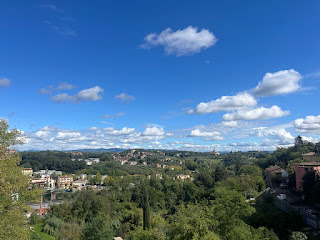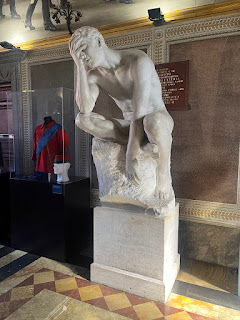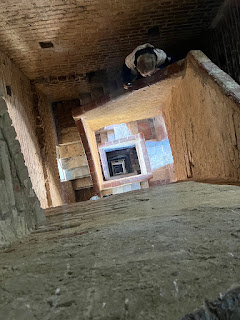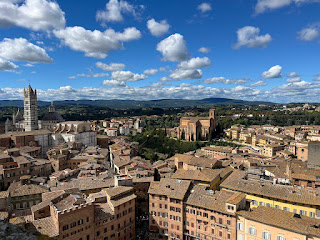Hola todos,
Day 3
I had an early train to catch this morning, so I grabbed an espresso at Roma Termini before hopping on my train. Off to Siena we go! We passed through the beautiful Tuscan countryside, which was so green and peaceful.
But unfortunately, my first train was late to my layover station in Chiusi-Chianciano by about 25 minutes, meaning I missed my connecting regional train. The next train was coming in a little over an hour, so I walked around the town for a bit (never getting too far from the train station--otherwise I get nervous!). It’s super small and was so quiet, especially compared to Rome.
While I was waiting at the station, some police officers came through and scanned everyone’s passports or Italian ID cards. I hadn’t heard of that happening before but noted: no day-trips via train without your passport. I got on my (new) train without an issue. Another hour or so through the scenic Tuscan countryside and I was finally in Siena.
The medieval entrance gate to the city. Reconstructed in 1604 after damage from a war, the gate was first mentioned in 1082.
Due to the delayed train, I missed check-in at the place I’m staying while here, but not to worry. I’m packing light, remember? It was a little inconvenient to schlep all of my stuff through the town, but there were so many tourists and backpackers and day-trippers that I hardly stood out.
On my walk into town from the train station was Giardini La Lizza. I stopped for a picnic lunch there and enjoyed the park’s view. Little did I know, the best was yet to come!
Finally, it was time to get my steps in.
First up was the Basilica Cateriniana di San Domenico, or the Basilica of St. Catherine (of Siena). She was a Dominican nun in the 13th century and is my confirmation saint. (I stumbled across her tomb yesterday in Rome). She was from Siena and attended this specific church, and even became a nun here. It's hard to overstate how special this church was for me to visit.
The church has a massive interior. It was built from 1226 to 1265 but the current ceiling is a reconstruction from later. The original ceiling is still partially visible in the sacristy off to the side.
Parts of the original ceiling.
One of the side chapels.
This church houses some incredible (and incredibly huge) paintings, as well as relics of St. Catherine. I took some time to just soak up what was there.
Then, it was back out into the streets of Siena. The streets in the town are super confusing: they wind their way back and forth and, since the town is built on several hills, up and down. And while it’s mostly pedestrian traffic on the streets, there are a few cars that are allowed to drive in, adding to the chaos.
Found the perfect restaurant!
This is the Salimbeni Palace, built in the 1200s by the powerful Salimbeni family. It's now a set of offices, I think.
Down the street is the Palazzo Tolomei, built from 1205 to 1212 by the Tolomei family. It is the oldest private residence in Siena.
The Salimbenis and Tolomeis were powerful families but sworn enemies, said to be the inspiration for Shakespeare’s Romeo & Juliet. There’s even a Juliet balcony on the Tolomei Palace.
The Juliet balcony. Right beneath it is a placard memorializing a Tolomei daughter.
Today, the competition continues, but in a less bloody fashion—they each house competing banks on their first floors.
There are a lot of wolf sculptures around Siena, harkening back to the city’s mythological founding. Wolf-raised Romulus founded Rome, but his twin brother Remus has two sons who fled to the countryside and founded Siena after Romulus killed their father. The myth states that they rode into Siena on one black horse and one white horse, giving the town of Siena it's distinctive colors of white and black.
It was finally time to check in to the convent where I was staying. It’s attached to the Basilica of San Francesco, which is run by Franciscan friars. I booked the stay through MonasteryStays.com and, though I initially worried it might be a scam, it ended up being a fabulous spot to stay.
With a private bathroom, it’s the nicest place I’m staying all trip! It's cheaper than some of the hostels I'm staying at during this adventure, too. So definitely check that website out. Checking in was a bit confusing, but once I got all checked in and settled into the room, I set off again (one backpack lighter) to see more of the town.
Il Campo is the center of the city. It used to be a hub of commerce and governance (the Palazzo Pubblico, the former government building, is on the plaza) and, as I’m learning, so much of the city’s history is tied to trade.
Apparently, they have a horse race here twice a year! It’s a quick race, though, since the Campo isn’t huge.
In 1297, Siena initiated a unified building code, which is so visible in Il Campo. The buildings’ roofs are roughly the same height, the windows are similar designs, and the exteriors all a similar color—what would become known as burnt Siena.
I continued my walk around the streets, ducking around random corners and seeing the souvenirs and enotecas scattered around.
Want a quick dessert? El Nino was giving out free samples of its delicious truffles and stuffed biscotti. Lots of limoncello-inspired and pistachio-based flavors. Yum!
It started to sprinkle, so I headed back to my room. I ended my night with Mass as San Francesco: it was the feast of St. Francis of Assisi, and there was a huge ceremony with appeared to be a ton of Siena’s local leadership as well as a cardinal. What a cool experience!
When we got out of Mass, it was *pouring*. Fortunately, I didn’t have very far to go! A full day in Siena to start, but a delightful one.
Day 4
I unintentionally slept in this morning. Because I have plenty of time here, I don’t need to jam pack everything and didn’t need to set an alarm. I awoke to a crisp morning and beautiful clear skies. A great day for walking around!
I started by stopping by a local cafe for WiFi and espresso (the convent is supposed to have WiFi but doesn’t—ah well, I can afford to unplug on occasion) before resuming my tour of Siena. I felt a little bit judged by the man behind the counter for asking for the WiFi password, but hey! I have avid fans I need to keep updated! (And, if nothing else, I have to send my family some "proof of life" photos occasionally.)
I picked up the walking tour where I left off yesterday. First up was the Loggia della Mercanzia, the former merchants’ guild headquarters.
Even the ceilings of this outdoor building were beautifully decorated.
Then the Fonte Gaia in Il Campo. It’s a central fountain with statues of wolves (remember the city’s origin story) and the virtues (the city’s strong Christian ties). Originally, the statues were nude but they were replaced with clothed ones in the 1860s. Very demure, very mindful. You can still see the originals in an exhibit in the Santa Maria della Scala, a museum I dropped by later.
The Palazzo Pubblico was the main building for governance in Siena. Now it houses the Museo Cívico, a museum that shows the priceless works of art that were made for the Palazzo and meant to be viewed as a message to those in authority.
The courtyard of the Palazzo.
Yet another stunning hand-painted ceiling.
The murals and paintings in the Palazzo are from the early 1300s. Unbelievable!
The Room of Peace, which has the most obvious symbolic paintings and is apparently a "can't miss" attraction, was closed for a wedding. Definitely a bummer, but I saw some incredible art nevertheless. And the museum had a free bathroom! Talk about a #TravelWin.
It was time for an espresso break, and I also grabbed a few ricciarelli, a local cookie that is crunchy on the outside, soft and chewy on the inside, and has a delicious almond flavor.
Included in my Museo Civico ticket was timed entry to its tower, the Torre del Mangia. The Torre is the third tallest medieval tower in Italy and was made in mid-1300s. It was supposed to be 400 steps to the top. (Because the tippy-top of the bell tower was closed off, I counted only 334 steps.
The stairs up were steep and the passageway was pretty tight. The ceiling was so low I had to bend over, and I hit my head several times.
On the way up, we were given these little teasers of the view!
And here was the top:
At the top, I overheard another couple mention that they’re from Arizona; as it turns out, I went to same high school as their son! What a small world.
After checking out the top (and catching my breath) for a bit, it was time for lunch. I stopped at a little hole-in-the-wall by chance and it was incredible. The prices were low but the food and wine were great. As it turns out, dinners there are reservation-only due to their limited capacity. But I was seated immediately for a late lunch. Perfetto!
Next was Santa Maria della Scala, an old hospital that is now a museum. Because of its religious origins, it has beautiful wall frescoes of religious art. I cannot believe how well-preserved the art there is, considering it's from the 1340s!
[Apparently, I grabbed zero photos of the art at Santa Maria della Scala. Either there were signs to not take photos, or I was just overwhelmed by that point.]
*Fun fact: St. Francis of Assisi was treated at the Santa Maria della Scala hospital! Probably for something related to his eyesight, a few years before his death.*
The building also houses a few underground chapels and an incredible private art collection that’s on display. These pieces are apparently usually housed in Siena’s national art museum, the Pinacoteca Nazionale di Siena, so it was a treat to see them here. You could get close enough to see the brushstrokes and the clumps of paint on the canvases. Just… wow.
Finally, it was time to end the evening as one ought while in Italy: eating gelato in a piazza. There are lots of gelaterias in Siena with overwhipped gelato, but Bar Pasticceria Nannini Posta was fabulous. I took it a five-minute walk to Il Campo and enjoyed the evening.
Siena is small and walkable and teeming with tourists during the day. I expected it to quiet down at night, and I suppose it was a little less busy, but it was still vibrant in the evening with families and couples, locals and tourists enjoying a Saturday evening.
Day 5
The town was a lot sleepier today (it is a Sunday, after all) with many fewer tourists but also fewer shops and restaurants open. Time to head back to my room to pack and prep for tomorrow morning's train.
I've absolutely adored my time in Siena. From the history of the town, to its small, local shops, to its glute-burning stairs and hills (with breath-taking views at the top, pun intended), Siena just kept giving and giving. Two and a half busy days were a perfect amount of time to do and see what I wanted. So while I am ready to move on, I already can't wait to go back.
Tina the ExploraDora
Cumulative steps: 114,864










































































































No comments:
Post a Comment